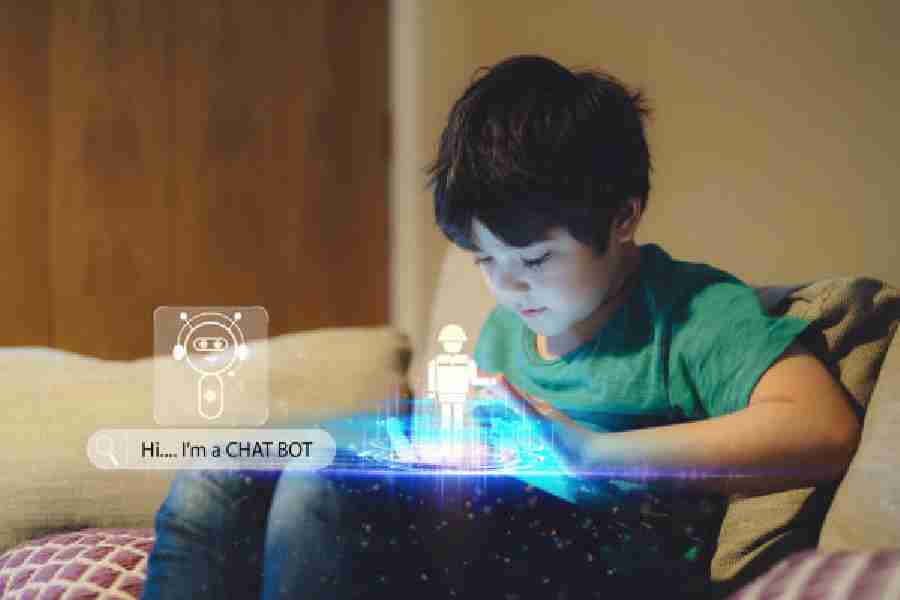The sixth graders at Khan Lab School, an independent school with an elementary campus in Palo Alto in the state of California in the US, were working on quadratic equations, graphing functions, Venn diagrams. But when they ran into questions, many did not immediately summon their teacher for help. They used a text box alongside their lessons to request help from Khanmigo, an experimental chatbot tutor that uses artificial intelligence.
The tutoring bot quickly responded to one student, Zaya, by asking her to identify specific data points in a chart. Then Khanmigo coaxed her to use the data points to solve her maths question. “It’s very good at walking you through the problem step by step,” Zaya said. “Then it congratulates you every time it helps you solve a problem.”
Khan Lab School students are among the first schoolchildren in the US to try out experimental conversational chatbots that aim to simulate one-on-one human tutoring.
Based on AI models underlying chatbots like ChatGPT, these automated study aids could usher in a profound shift in classroom teaching and learning. Simulated tutors could make it easier for many self-directed students to hone their skills, delve deeper into topics that interest them or tackle new subjects at their own pace. Such unproven automated tutoring systems could also make errors, foster cheating, diminish the role of teachers or hinder critical thinking in schools. Or, like a legion of promising tech tools before them, the bots may simply do little to improve academic outcomes.
Khanmigo is among the wave of new AI-powered learning tools. It was developed by Khan Academy, a nonprofit education giant whose video tutorials and practice problems have been used by tens of millions of students.
Sal Khan, the founder of Khan Academy — and of Khan Lab School, a sepa-rate nonprofit organisation — said he hoped the chatbot would democratise student access to individualised tutoring. He also said it could greatly help teachers with tasks like lesson planning, freeing them up to spend more time with their students.
Khan Academy developed the bot with guardrails for schools, Khan said. These include a monitoring system that is designed to alert teachers if students using Khanmigo seem fixated on issues like self-harm.
Thousands of US schools already use analytical AI tools like plagiarism-detection systems and adaptive learning apps that are designed to automatically adjust lessons to students’ reading levels. But proponents envision the new AI-assisted tutoring systems as education game changers because they act more like student collaborators than inert pieces of software. The AI’s facility with language has prompted some enthusiasts to declare that simulated tutors could soon be as individually responsive to students as human tutors.
Whether the bots can provide the kind of empathetic support and genuine encouragement that can make human tutors especially effective is not yet known.
Khan Academy began developing chatbot tutoring software last fall with the aim of assessing AI’s potential to improve learning. The system uses GPT-4, a large language model created by OpenAI, the lab behind ChatGPT.
Khan said he wanted to create a system to help guide students, rather than simply hand them answers. So developers at Khan Academy engineered Khanmigo to use the Socratic method. It often asks students to explain their thinking as a way of nudging them to solve their own questions.
Khanmigo offers help on a broad variety of subjects: elementary school maths, middle school American history, high school civics and college-level organic chemistry. It also has features that invite students to chat with fictional characters like Winnie-the-Pooh or simulated historical figures such as Marie Curie.
AI systems based on large language models can also concoct false information. That is because the models are engineered to predict the next word in a sequence. They do not stick to facts.
To improve Khanmigo’s accuracy in maths, developers at Khan Academy created a multistep process: the system works out answers to a maths problem behind the scenes and then checks it against a student’s answer. Even so, the Khan Academy tutoring system displays a warning at the bottom of the screen: “Khanmigo makes mistakes sometimes.”
Khan Lab School, where annual tuition costs more than $30,000, offers an ideal test bed for tutoring bots. The Silicon Valley school has small classes and an entrepreneurial philosophy encouraging children to pursue their passions and learn at their own pace. Its tech-savvy students are accustomed to tinkering with digital tools.
One morning this spring, Jaclyn Major, a STEM specialist at Khan’s elementary school, looked on as her students playfully tested the bot’s limits. One student asked Khanmigo to explain a maths problem using song lyrics. Another requested maths help in “Gen Z slang”. “Will you do me one more favour and explain everything in Korean?” a third said in a text conversation with the chatbot. Khanmigo dutifully obliged. Then it nudged each student back to the maths task at hand.
NYTNS











